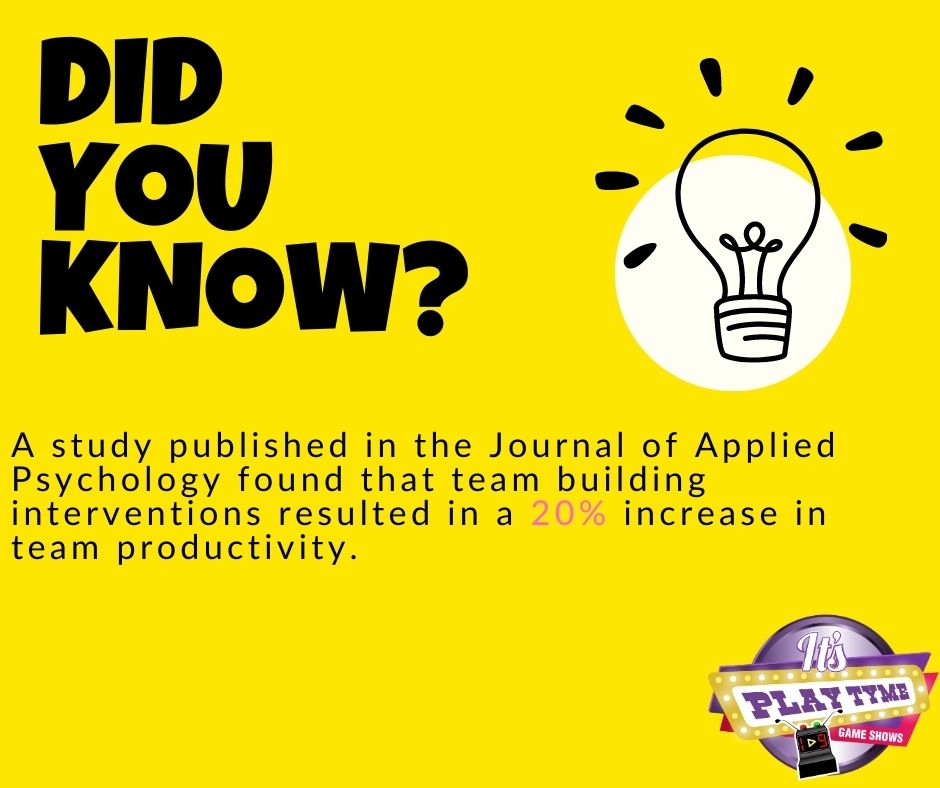Corporate Team building exercises are often seen as a way to improve teamwork, collaboration, and office morale.
However, some experts argue that these activities are ineffective and can even be insulting to team members.
The real issues that hinder team performance are often related to leadership problems, such as a lack of communication, unaddressed conflict, role confusion, or an inexperienced leader.
Team building activities alone cannot solve these underlying issues alone.
Leaders should also focus on addressing the “root causes” of their team dysfunction and encouraging open conversations about culture, norms, energy, and feelings in the workplace.
So the bottom line question is?
Are Team Building Activities Effective?
Key Takeaways:
- Team building activities are not the sole solution to team effectiveness.
- Leadership plays a crucial role in creating a cohesive and successful team.
- Real business issues, such as strategy, conflict, and role clarity, impact team performance more than team-building exercises alone.
- Effective debriefing and reflection can enhance the value of team-building activities.
- When choosing these activities, consider their relevance and effectiveness in addressing specific team issues.
The Benefits of Team Building Exercises

Team building exercises, when implemented effectively, can bring numerous benefits to a team’s development, ultimately improving teamwork and enhancing collaboration.
These activities serve as an opportunity for team members to connect, build trust, and develop stronger relationships.
By participating in team-building exercises, individuals get to know each other better, fostering a sense of camaraderie and unity within the team.
One of the key benefits of team building is the improvement of teamwork.
These activities promote cooperation, communication, and problem-solving skills among team members, enabling them to work together more effectively towards common goals.
By engaging in shared experiences and overcoming challenges as a team, individuals learn to trust and rely on each other, leading to improved collaboration and synergy in the workplace.
Furthermore, team building exercises contribute to a positive work environment.
They create an atmosphere of fun and enjoyment, reducing stress and boosting morale.
When team members feel more relaxed and comfortable in their work environment, they are more likely to engage actively, contribute their ideas, and support each other.
This positive energy translates into increased productivity and overall job satisfaction.
The Fallacy of Team-Building Exercises
Most leaders know, Team-building exercises have long been touted as a panacea for team dysfunction and a means to create a good team.
However, this belief is misguided and based on a fallacy. The success of a team is not solely determined by how well they bond during these exercises.
Rather, it is influenced by a range of factors such as clear strategy, effective conflict resolution, role clarity, minimal bureaucracy, and a focus on collaboration and innovation.
These fundamental issues cannot be addressed through team-building exercises alone.
The reasons why these exercises alone are not effective in creating a high-performing team are multi fold.
First, activities alone do not address the underlying issues that hinder team performance, such as poor leadership, lack of communication, or unaddressed conflict.
These issues require targeted interventions and open conversations to be resolved effectively.
Second, some exercises often focus on superficial aspects, such as trust falls or icebreakers, rather than addressing the complex dynamics that impact team effectiveness in the workplace.
“While team-building exercises may foster camaraderie and improve morale, they maybe insufficient in addressing the core issues that hinder team performance.”
Lastly, team-building exercises can sometimes be perceived as forced, contrived, or even insulting to team members.
Not everyone enjoys or benefits from the same activities, and it is essential to consider the diverse needs and preferences of the group when designing team-building initiatives.
In some cases, these exercises can contribute to a negative response if the group feels unengaged.
| 3 Reasons Why Some Team Building Exercises Can Be Ineffective |
|---|
| Lack of focus on addressing underlying issues |
| Superficial approach to teamwork |
| Potential for negative impact on team morale |
Instead of relying solely on team-building exercises, leaders should also focus on addressing the real business issues that hinder team performance.
By fostering open communication, providing leadership support, and addressing conflicts and role confusion, leaders can create an environment conducive to team success.
A Team building event can still have value when used in conjunction with effective debriefing and reflection, but they should not be seen as the sole solution to team effectiveness.
The Importance of Leadership in Team Dynamics
Leadership is a critical factor in creating a good and successful team.
Effective leadership sets the foundation for a cohesive and high-performing team.
Leaders establish goals, strategies, encourage open communication, resolving conflicts, promoting collaboration and innovation while providing support and recognition to team members.
A skilled leader understands the dynamics of the team and takes proactive steps to address any underlying issues that may hinder team performance.
One of the key responsibilities of a leader is to hire the right people for the team.
By selecting individuals who possess the necessary skills, experience, and attitude,
Also, a leader plays a crucial role in establishing and maintaining a positive team culture.
This involves setting norms and expectations, promoting a sense of shared purpose, and encouraging a supportive and inclusive work environment.
Furthermore, effective leadership involves fostering open communication and addressing conflicts within the team.
A leader should create a safe space where employees feel they are able to express their concerns, give their opinions, and ideas.
By encouraging open dialogue and actively listening to team members, a leader can identify and address any underlying issues that may hinder team dynamics.
Conflict resolution is also an essential skill that a leader must possess to facilitate a productive and harmonious team environment.
Real Business Issues Hindering Team Performance
Team performance is not solely determined by the lack of team bonding. In reality, there are various real business issues that can hinder a team’s ability to work effectively and cohesively.
By addressing these underlying issues, leaders can create an environment that fosters overall team performance.
One common issue that impacts team performance is a lack of clear strategy. When team members are unsure of the goals and objectives they are working towards, it can lead to confusion and inefficiency.
Similarly, unaddressed conflicts within the team can create tension and hinder collaboration. Role confusion, where team members are unsure of their responsibilities and expectations, can also lead to decreased productivity.
Other challenges that can hinder team performance include slow processes, over-reliance on measurement and quantitative goals.
Lack of conversations about culture and norms. Inexperienced leaders show a lack of focus on experimentation and innovation.
These issues can create a negative work environment and prevent teams from reaching their full potential.
Real Business Issues Hindering Team Performance
| Issue | Description |
|---|---|
| Lack of clear strategy | When team members are unsure of the goals and objectives they are working towards, it can lead to confusion and inefficiency. |
| Unaddressed conflicts | Tension and lack of collaboration can arise when conflicts within the team are left unresolved. |
| Role confusion | When team members are unsure of their responsibilities and expectations, it can lead to decreased productivity. |
| Slow processes | Inefficient processes can slow down the team’s progress and hinder productivity. |
| Over-reliance on measurement and quantitative goals | A focus solely on measurable outcomes can hinder creativity and innovation within the team. |
| Lack of conversations about culture and norms | An absence of open discussions about team culture and expected norms can create a negative work environment. |
| Inexperienced leaders | Leaders who lack experience or proper training may struggle to effectively lead and support their teams. |
| Lack of focus on experimentation and innovation | Teams that do not prioritize experimentation and innovation may struggle to keep up with changing market demands. |
The Role of Debriefing and Reflection
While team-building exercises may not be the magic solution to team effectiveness, they can still have value when used in conjunction with effective debriefing and reflection.
Debriefing allows team members to reflect on their experiences, identify strengths and weaknesses. By asking insightful debrief questions, leaders can guide the team in understanding and identifying areas for improvement.
Importance of Debriefing
Debriefing is a crucial component of the team-building process as it provides an opportunity for team members to review their performance, evaluate their progress, and discuss any challenges or concerns.
Through debriefing, teams can identify what worked well, what didn’t, and why. This reflection and analysis enable team members to gain a deeper understanding of their individual and collective strengths and weaknesses, fostering growth and improvement.
“Debriefing is a valuable tool for teams to gain insights, build self-awareness, and enhance their collaboration. It allows team members to openly discuss their experiences, share perspectives, and develop strategies to address challenges. Through debriefing, teams can learn from their mistakes, celebrate successes, and continuously refine their approach.”
Application of Lessons Learned
Effective debriefing goes beyond just reflecting on past experiences— it also involves applying the lessons learned to future situations.
Team leaders play a crucial role in guiding their teams in translating insights gained from the debriefing process into actionable strategies and behaviors.
This can involve setting specific goals, defining new communication protocols, revising processes, or implementing changes overall.
| Benefits of Debriefing and Reflection in Team Building |
|---|
| 1. Enhances self-awareness and individual growth |
| 2. Identifies areas for improvement and development |
| 3. Fosters open communication and trust within the team |
| 4. Promotes collaboration and knowledge sharing |
The Role of Leadership in Debriefing and Application
Leadership plays a critical role in the debriefing process and the application of lessons learned from team-building activities. Effective debriefing allows team members to reflect on their experiences, identify strengths and weaknesses, and gain valuable insights that can be applied to their daily work. As a leader, it is important to facilitate meaningful debrief conversations by asking thought-provoking questions that encourage deeper reflection.
By guiding the team through the debriefing process, leaders can help them understand the underlying dynamics that impact team effectiveness. This includes addressing issues such as communication breakdowns, lack of trust, or role confusion. Furthermore, leaders should ensure that the debriefing leads to actionable takeaways that can be directly applied to the team’s work.
Applying the lessons learned from team-building activities is where leadership truly shines. Leaders should actively support and encourage behavior changes based on the insights gained from the debriefing process. They should provide the necessary resources, training, and guidance to facilitate the application of these lessons in the team’s day-to-day activities. By doing so, leaders can foster continued growth and development, ultimately enhancing team effectiveness.
The Importance of Effective Debriefing
Effective debriefing goes beyond simply discussing the team-building activity itself. It involves digging deeper into the experiences and emotions of the group. It explores the root causes of challenges and successes, and encouraging open and honest dialogue. Through debriefing, leaders can gain a better understanding of the team’s dynamics and identify areas for improvement. This information can then be utilized to create actionable strategies that address the team’s specific needs and enhance overall team effectiveness.
| Key Questions for Debriefing | Benefits of Applying Lessons Learned |
|---|---|
| What were the main takeaways from the team-building activity? | Improved communication and collaboration |
| Did any challenges or conflicts arise during the activity? How were they resolved? | Increased problem-solving skills |
| How did team members work together? Were there any notable strengths or weaknesses? | Enhanced trust and understanding among team members |
| What can be learned from this activity that can be applied to our daily work? | More effective decision-making processes |
By asking these key questions and actively involving team members in the debriefing process, leaders can foster a culture of continuous learning and improvement within the team. This ultimately leads to enhanced team effectiveness, as team members feel valued and empowered to apply the lessons learned from team-building activities in their day-to-day work.
The Benefits and Advantages of Team Building Exercises
Team building is important, and choosing the right exercises, can bring numerous benefits to a team’s development.
These activities serve as an opportunity for team members to connect, build trust, and develop stronger relationships.
By participating in a few team-building exercises, individuals get to know each other better, fostering a sense of camaraderie and unity within the team.
One of the key benefits of team building is the improvement of teamwork. These activities promote cooperation, communication, and problem-solving skills.
By engaging in shared experiences and overcoming challenges as a team, individuals learn to trust and rely on each other, eventually, leading to improved collaboration towards a common goal at work.
Furthermore, team building exercises contribute to a positive work environment.
Team building creates an atmosphere of fun and enjoyment, reducing stress and boosting morale.
When team members feel more relaxed and comfortable in their work environment, they are more likely to engage actively, contribute their ideas, and support each other.
This positive energy translates into increased productivity and overall job satisfaction.
Choosing The Right Team Building Activities

When it comes to team building activities, it’s essential to choose ones that are not only engaging and fun but also effective in promoting teamwork and collaboration.
Here are a few key factors to consider when selecting a particular exercise:
- Relevance: Look for activities that directly address the specific issues your team is facing. For example, if communication is a challenge, opt for activities that focus on improving communication skills.
- Effectiveness: Consider the track record of the activities you’re considering. Are they proven to be effective in improving team dynamics and fostering collaboration? Look for reviews and testimonials from other teams who have tried the activities.
- Team goals: Align the activities with your team’s goals and objectives. If your team is aiming to improve problem-solving skills, choose activities that require critical thinking and problem-solving.
- Team size and composition: Take into account the size and composition of your team. Some activities may work better for smaller teams, while others may be more suitable for larger groups.
Keep in mind that these activities should be tailored to the unique needs and dynamics of your team.
What works for one team may not necessarily work for another.
So, check the temperature of your team by involving them in the decision-making process.
Make sure to gather their input on the types of activities they find most beneficial and enjoyable.
| Activity | Purpose | Key Benefits |
|---|---|---|
| Dragon’s Den | Encourages innovation | Enhanced problem-solving skills, creativity, and collaboration |
| Detective Work | Develops communication and critical thinking | Improved analytical skills, and attention to detail |
| Make a Shape | Fosters creativity, collaboration, and adaptability | Enhanced problem-solving skills, communication, and teamwork |
| Scavenger Hunt | Promotes communication, and problem-solving | Improved collaboration, creativity, and time management |
Remember, the goal of team building activities is to enhance team effectiveness, strengthen relationships, and improve overall collaboration within the team.
By carefully selecting activities that are relevant, effective, and aligned with your team’s goals, you can maximize the impact of team building exercises and create a more cohesive and productive team.
Related Posts
- 4 Hoboken Venue Ideas for Corporate Games
- Daily Inspiring Question of the Day for Work | Boost Morale
- Fun Holiday Icebreaker Questions & Ideas for Your Next Party!
- 6 Popular Game Show Ideas for Team Building
- Recognizing Excellence: Honoring Employee of the Month
Virtual Team Building in the Modern Workplace
In today’s modern workplace, the rise of remote teams has presented new challenges for team building. As more teams collaborate online, it is important to adapt team-building strategies to the virtual environment. Virtual team building activities can help foster collaboration, communication, and team bonding among remote team members. These activities leverage technology to create engaging and interactive experiences, promoting a sense of connection and teamwork.
Virtual team building activities can take various forms, such as online escape games, virtual scavenger hunts, and virtual team challenges. These activities provide opportunities for team members to work together, solve problems, and bond despite being physically separated. By participating in these activities, remote team members can build trust, enhance communication skills, and develop stronger relationships with their colleagues.
Virtual team building strategies can also include virtual team meetings and brainstorming sessions. These allow team members to come together virtually, exchange ideas, and collaborate on projects. By utilizing video conferencing platforms and virtual collaboration tools, remote teams can maintain effective communication and collaboration, resulting in improved team performance.
Benefits of Virtual Team Building
Virtual team building offers several benefits for remote teams. It helps combat feelings of isolation and promotes a sense of belonging among team members.
The interactive nature of virtual team building activities creates an engaging and enjoyable experience, making work more enjoyable for remote team members.
“Virtual team building activities provide a great opportunity for remote team members to connect, collaborate, and build relationships despite the physical distance.”
Furthermore, virtual team building activities can boost team morale and motivation. They provide a break from routine work and allow team members to recharge and have fun together. This, in turn, can result in increased productivity and a positive work atmosphere.
In conclusion, virtual team building is an essential strategy for fostering collaboration, communication, and team bonding in the modern workplace. By embracing virtual team building activities and strategies, remote teams can overcome the challenges of distance and create a more connected and cohesive work environment.
FAQ

Are team-building activities effective?
While some team-building activities contribute to improved teamwork and office morale, they are not a standalone solution for team dysfunction.
The effectiveness of a team is influenced by leadership, communication, conflict resolution, and role clarity.
What are the real issues that hinder team performance?
The real issues that hinder team performance are often related to leadership problems. Lack of communication, unaddressed conflict, role confusion, or an inexperienced leader may be an underlying issue.
These issues need to be addressed to improve teamwork and overall team performance.
Can team-building exercises address these underlying issues?
Team-building exercises alone cannot solve the underlying issues that impact team effectiveness.
Instead, leaders should also focus on addressing the root causes of team dysfunction and fostering open conversations about culture, norms, energy, and feelings in the workplace.
What role does leadership play in team effectiveness?
Leadership plays a critical role in creating a cohesive and successful team.
A team leader is responsible for hiring talent, establishing clear goals and strategies, fostering open communication, addressing conflicts.
They also encourage collaboration, innovation, and provide recognition and support as well.
What are some common issues that hinder team performance?
Some common issues that hinder team performance include a fuzzy or missing strategy, unaddressed conflicts. Role confusion, slow processes, over-reliance on measurement and quantitative goals.
Lack of conversations about culture and norms, inexperienced leaders, and a lack of focus on experimentation and innovation.
Do team-building activities have any benefits?
While team-building activities alone may not solve all team issues, they can certainly enhance teamwork, and improve communication and collaboration.
The list goes on as they can foster creativity and innovation, which creates a positive and healthy work environment.
Another reason why team building is important is to help team members build trust and develop stronger relationships.
How can leaders apply lessons learned from team-building activities?
Leaders should facilitate meaningful debrief conversations, asking thought-provoking questions that allow team members to reflect on their experiences and identify actionable takeaways.
They should guide the team in applying these lessons to their daily work, encouraging behavior changes and providing support and resources for continued growth and team effectiveness.
What are some effective virtual team-building strategies?
Virtual team-building activities, such as online escape games, virtual scavenger hunts, and virtual team challenges, can promote collaboration, communication, and team bonding among remote team members.
Can team-building activities alone create an effective team?
Team-building activities alone cannot create a truly effective team. It is crucial for leaders to address the underlying issues that hinder team performance and create a supportive and conducive work environment.
Team-building activities should be used strategically in conjunction with reflective debriefing and application to contribute to team development.
What is the conclusion on the effectiveness of team-building activities?
Team-building activities can have value when used in conjunction with effective debriefing and reflection.
However, they should not be seen as the magical solution to team effectiveness.
Effective leadership, open communication, and a focus on addressing real business issues are key in building a truly effective team.
Conclusion
In conclusion, while team-building activities alone may not be the magical solution to creating an effective team, they can still play a crucial role in enhancing teamwork, communication, and collaboration.
It is important to remember that the root causes of team dysfunction are often related to leadership issues and real business challenges, such as a lack of communication, unaddressed conflicts, or role confusion.
To build a truly effective team, leaders should focus on addressing these underlying issues and creating a supportive work environment.
Leadership plays a crucial role in creating a cohesive and strong team.
A team leader should establish clear goals and strategies, foster open communication, address conflicts, encourage collaboration and innovation. They should also provide recognition and support to team members.
Team-building activities, when used strategically and in conjunction with reflective debriefing and application, can contribute to creating a more cohesive and productive team.
Virtual team building activities have also become relevant in the modern workplace, especially with the rise of remote work and virtual teams.
In summary, team-building activities should be seen as a complement to effective leadership and addressing real business issues, rather than a standalone solution.
By focusing on leadership, addressing underlying challenges, and using team-building activities strategically, you can create an environment leading to the development of an effective and high-performing team.

Team Leaders! Book a live game show experience today!
Contact us for further details.
We come to your office, venue or off-site location..
For Immediate assistance by text – 917-670-4689
No deposit required. 5-star rated on google.





